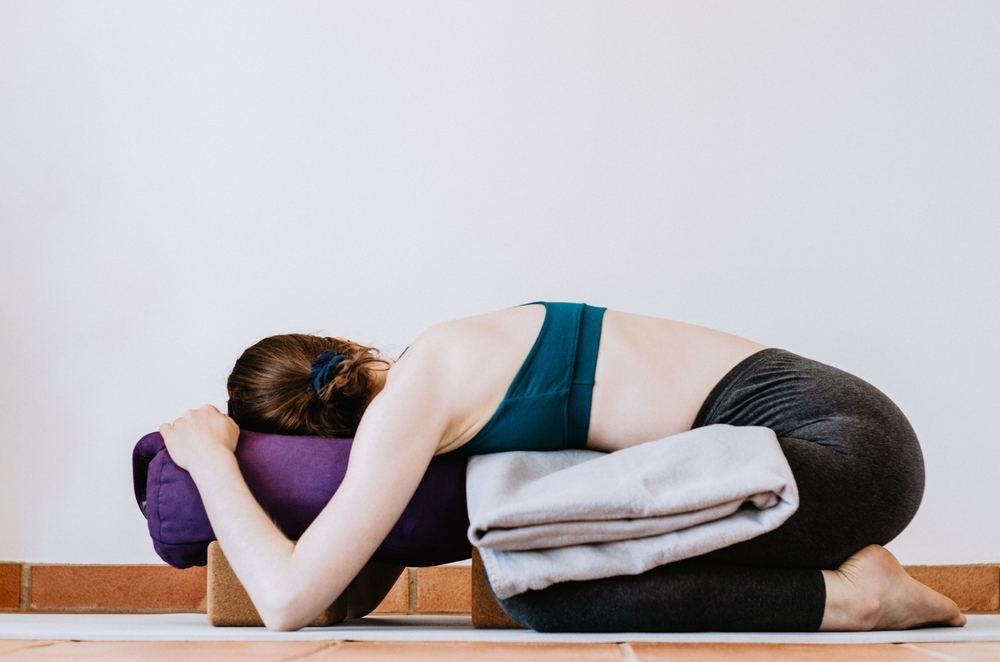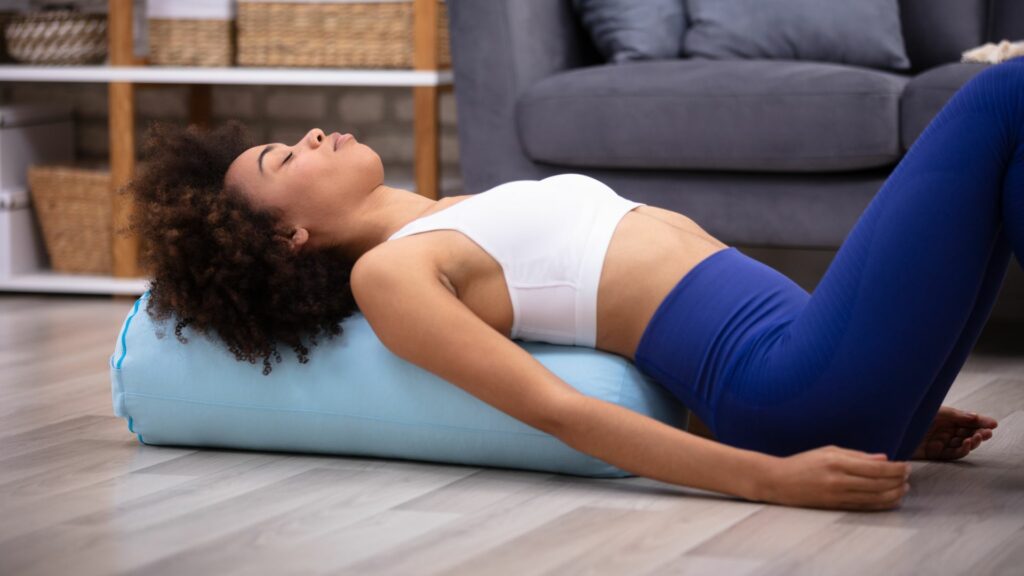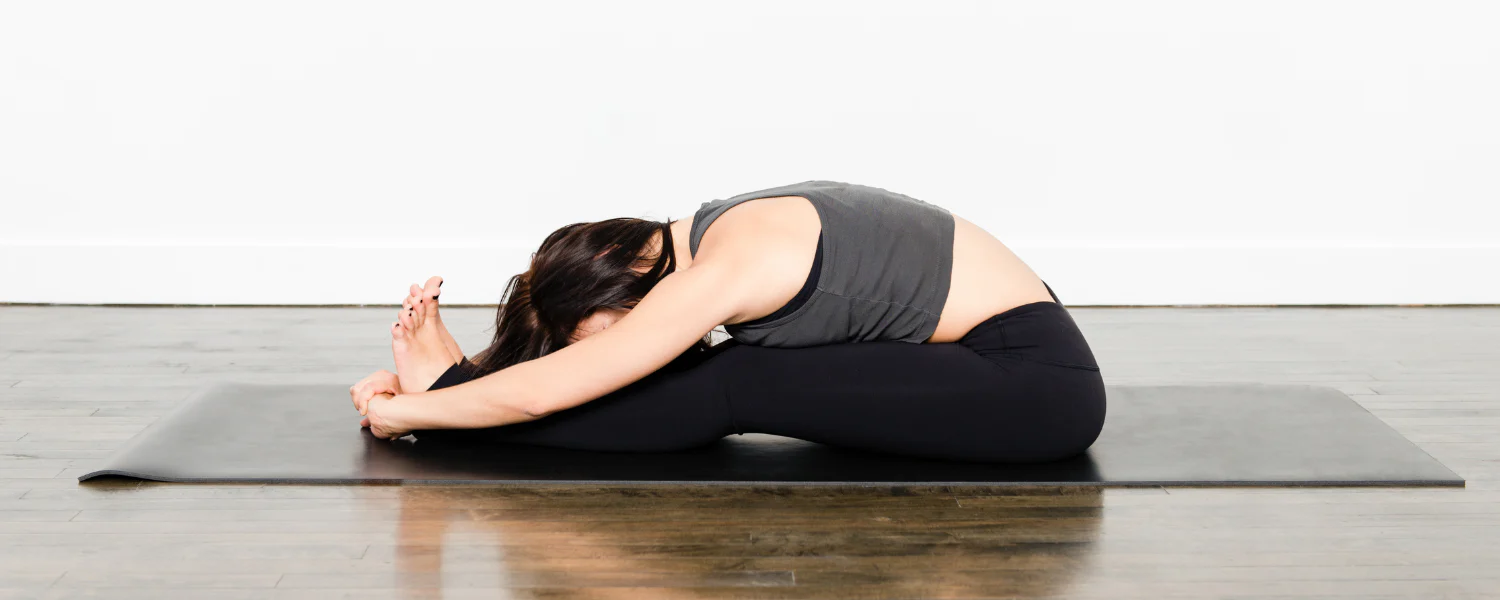
Restorative Yoga: Relax, Recharge, and Find Your Balance
Restorative yoga is all about supporting your body in different poses with props like blankets, pillows, and bolsters. Instead of focusing on building strength or flexibility, restorative yoga aims to relax and calm your body and mind. This practice is typically done in a quiet, soothing environment, often with soft music or calming sounds to enhance the experience.
Whether you’re recovering from an injury, managing chronic stress, or just need some time to relax and recharge, restorative yoga can benefit people of all ages and fitness levels. By making restorative yoga a regular part of your routine, you can experience its many proven benefits for your health and well-being.
Restorative Yoga as Part of Your Daily Routine

To get started with restorative yoga, find a peaceful, comfortable space where you can fully relax. Here’s what you’ll need:
- A yoga mat
- Blankets, pillows, or bolsters to support your body in different poses
- Comfortable, loose-fitting clothes that allow you to move freely
Begin by lying on your back, feet on the floor, and arms by your sides. Take a few deep breaths to settle into the moment and allow your body to relax. Then, choose one or more restorative poses to hold for an extended period of time. Common restorative poses include:
- Child’s Pose
- Supported Fish Pose
- Supported Bridge Pose
- Reclining Bound Angle Pose
Using props to support your body will help you hold each pose comfortably for 5-15 minutes. During each pose, focus on your breathing and let go of any tension. When you’re ready, gently transition out of the pose and take a moment to rest before moving into another one or finishing your practice.
Health Benefits of Restorative Yoga

Restorative yoga offers numerous health benefits, making it a great addition to any fitness or wellness routine. Some of the key benefits include:
- Improved Flexibility and Muscle Tone: While restorative yoga isn’t about intense stretching, it can still help improve flexibility and muscle tone over time.
- Reduced Stress & Anxiety: One of the biggest advantages of restorative yoga is its ability to lower cortisol (the stress hormone) levels, helping you feel more relaxed and less anxious.
- Better Sleep: The calming nature of restorative yoga helps improve sleep quality, which is essential for weight loss and overall health.
- Deep Relaxation & Calmness: The focus on breath and mindfulness helps calm the nervous system, leaving you feeling more centered and peaceful.
- Improved Digestion: Gentle movements and deep relaxation can support healthy digestion by calming the body and promoting proper function.
Restorative Yoga and Weight Loss
:max_bytes(150000):strip_icc()/beautiful-young-yoga-girl-lying-in-asana-shavasana-653952114-74c56c2a731b439b8e9f7d0dc0b9dbd2.jpg)
Although restorative yoga isn’t a high-intensity workout, it can still play a valuable role in supporting your weight loss journey. Here’s how:
- Improved Flexibility and Muscle Tone: As your flexibility and muscle tone improve, you may experience less pain and stiffness, allowing you to engage in other forms of physical activity more effectively, which can contribute to weight loss.
- Stress Relief: Reducing stress is crucial for weight loss. High cortisol levels can lead to weight gain, particularly around the belly area. By practicing restorative yoga, you can help regulate cortisol levels and lower stress, making it easier to lose weight.
- Better Sleep: Quality sleep is vital for weight management. When you get enough rest, your body regulates metabolism and appetite, making it easier to maintain a healthy weight.
- Mindfulness and Focus: Restorative yoga encourages mindfulness and relaxation, which can help you make better food choices, manage emotional eating, and stay motivated on your weight loss journey.
By incorporating restorative yoga into your routine, you can reduce stress, improve sleep, and create a more relaxed and healthy lifestyle that supports weight loss.
Is Restorative Yoga Good for Beginners?

Yes! Restorative yoga is an excellent choice for beginners. Since the practice involves holding poses for longer periods with the support of props, it’s a gentle way to ease into yoga. This style of yoga is especially beneficial for those new to exercise, dealing with stress, or recovering from physical or mental health challenges.
Before starting any new exercise routine, it’s always a good idea to check with your healthcare provider, especially if you have underlying health conditions.
Tips for Incorporating Restorative Yoga into Your Weight Loss Routine

If you’re interested in using restorative yoga to support your weight loss efforts, here are some tips to help you get started:
- Find a Class or Instructor: Joining a class or working with a restorative yoga instructor can be a great way to learn the proper techniques and get guidance. Look for classes that focus on restorative yoga for a truly relaxing experience.
- Create a Home Practice: If attending a class isn’t an option, you can still practice at home. All you need is a quiet space and a few basic props like blankets, pillows, and blocks. There are plenty of online resources to guide you through setting up your own restorative yoga practice at home.
- Combine with Other Forms of Physical Activity: While restorative yoga may not burn as many calories as high-intensity workouts, it’s a valuable complement to other forms of exercise. Consider pairing it with cardio, strength training, or other yoga styles like vinyasa to create a well-rounded fitness routine.
The Science Behind Restorative Yoga for Weight Loss
:max_bytes(150000):strip_icc()/beautiful-young-yoga-girl-lying-in-asana-shavasana-653952114-74c56c2a731b439b8e9f7d0dc0b9dbd2.jpg)
Studies show that restorative yoga can help with weight loss by reducing subcutaneous fat. One study by the University of California found that regular restorative yoga practice helps reduce cortisol levels, which can aid in weight management. Additionally, National Institutes of Health-funded studies have shown that restorative yoga can be part of an effective weight loss program by reducing stress and promoting relaxation.
Frequently Asked Questions
How does Restorative Yoga compare to other types of yoga?
Restorative yoga is much gentler compared to more dynamic forms like vinyasa or power yoga. It focuses on deep relaxation and breathwork, using props to support the body during longer-held poses.
Do I need props for Restorative Yoga?
While props are helpful and encouraged, they’re not absolutely necessary. Props like bolsters, blankets, and blocks are used to support the body, making it easier to relax into each pose, but you can always practice without them if needed.
How does Restorative Yoga help reduce belly fat?
While restorative yoga isn’t a fat-burning workout, it can help reduce stress and improve sleep—two factors that can influence weight loss and fat reduction, particularly around the belly area. Lower cortisol levels can lead to less belly fat over time.
Which yoga styles are best for supporting weight loss?
While restorative yoga is calming and supportive, for weight loss, a more active form of yoga like vinyasa or power yoga may help burn more calories. Combining these dynamic practices with restorative yoga for recovery can provide a balanced approach to weight loss.
Conclusion
Restorative yoga offers a gentle yet powerful way to support weight loss, reduce stress, and improve overall well-being. It’s an accessible practice that people of all ages and fitness levels can benefit from. Whether you choose to attend a class, create a home practice, or combine it with other forms of exercise, restorative yoga can be a valuable tool in your weight loss journey.
By making restorative yoga a regular part of your routine, you can enjoy the many benefits it has to offer—like better sleep, reduced stress, improved flexibility, and a calmer mind—while supporting your weight loss goals in a healthy and sustainable way.
If you’re ready to add restorative yoga to your routine, just remember: It’s not about pushing yourself. It’s about finding peace, reducing stress, and nurturing your body and mind. So take your time, use your props, and allow yourself to fully relax and recharge!
